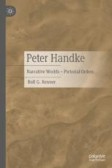Search
Search Results
-
Animals and Animality in Saki’s Satirical Short Stories
The British writer Hector Hugh Munro (1870–1916), who published under his pen name Saki, is to this day mostly known for the fable-like satirical...
-
The Satirical Rhetorics of [Re]Tweeting Birds
This chapter reins together a range of avian voices on Twitter and analyzes the conceptual and comedic output of accounts claiming to be run by birds...
-
The Lacking Satirical Animals of Mary Shelley’s The Last Man
Mary Shelley’s novel The Last Man can be read as a satire of nineteenth-century British politics. Shelley uses her characters’ ambiguous animality to...
-
“Thanks a lot, big brain”: Satirical Misanthropy in Kurt Vonnegut’s Galápagos
This chapter examines Kurt Vonnegut’s novel Galápagos as develo** a form of misanthropy whereby the evolutionary malfunctions of Homo sapiens are...
-
Barthold Heinrich Brockes and Nature Writing
Historical studies in search of nature writing in German literature occasionally mention the Early Enlightenment poet Barthold Heinrich Brockes, who...
-
The Thrill of the Chaise: Gendering the Phaeton in Eighteenth-Century Literary and Satirical Culture, c.1760–1820
Deidre Lynch in The Economy of Character argues that the “new ‘world of moving objects’ was one in which new forms for imagining and enforcing social...
-
Introduction: “Writing Is the Divine Revelation”
As a facet of Blake’s creative output alongside his pictorial art and printmaking, his writings are prodigious. While considerable scholarly...
-
“A green Parrot for a good Speaker”: Writing with a Birds-Eye View in Eliza Haywood’s The Parrot
After publishing The Female Spectator between 1744 and 1746, a periodical widely considered to be one of the first periodicals written by women for...
-
Gender Controversy in Women’s Writing
The medieval and early Tudor gender controversy included female authors and voices that ranged from dignified defenses to shrewish ripostes,...
-
The Spaces in Which I/Eye Gaze: J.C. Mangan’s Satirical Appropriation of Colonial Views
Colonial appropriations of colonised subjects’ lands translated into a deformed portrayal of both lands and colonised peoples. Postcolonial theory...
-
A Career in Professional Writing
Professional writers, regardless of whether they are employed directly by a business or engaged on a casual basis, require a professional approach...
-
The Transformation of One’s Own Writing
The text, written in 1994, forms a central mediating link between Handke’s fictional texts and the author’s authentic notes. It is linked to both in...
-
From Brehms Tierleben to “A Report to an Academy”: Franz Kafka’s Animal Story Read as a Critical Commentary on Writing About Nature
Under the influence of cultural (literary) animal studies, a kind of paradigmatic shift has taken place among the Kafka studies community. No longer...
-
Writing on Keats, Writing with Keats: Ghostlier Intonations, Marginalia, and Epigraphs Among Friends—Or, My Keats
This chapter explores McLane’s history of reading, citing, annotating, and thinking about Keats. She draws on Matthew Rohrer’s notion of writing...
-
A** the Classics: Terry Pratchett’s Satirical Animals and Detective Fiction
Best known as fantasy fiction, Terry Pratchett’s City Watch octet pays homage to and unsettles the traditional crime-scene-centric human/animal...
-
Irony and sentiment in the literary field: Prešeren’s sonnets and the Slovenian alphabet-censorship war
Restoration censorship forced European Romantic literature to retreat from society and politics into subjective intimacy, fantasy, mythology,...
-
The Primacy of Speech Over Writing in Hasidic Society
This chapter examines the status of writing in the Hasidic, mystically oriented sector of Eastern European Jewish society in the nineteenth century....
-
Outrageous Humor: Satirical Magical Realism
With growing recognition of the unreliability of political rhetoric, Bowers considers the sub-genre of magical realist satire in relation to World...
-
Nineteenth-Century American Anti-extinction Humour: “A Polar Whale’s Appeal” as Environmentalist Animal Satire
My chapter examines the satirical aspects of “A Polar Whale’s Appeal”, an anonymous letter to the editor published in The Friend—a Honolulu newspaper...
-
The Primacy of Speech Over Writing in Mitnagdic Society
Chapter Five examines the status of writing among the Hasidim's fierce opponents, the rabbinic, legally oriented Mitnagdim. Despite the many...
